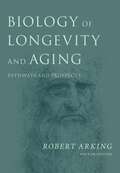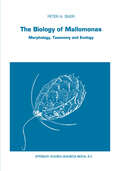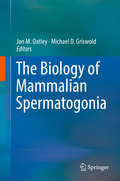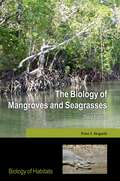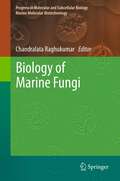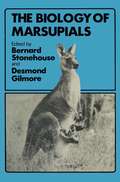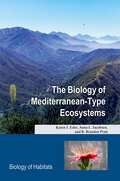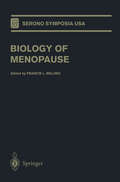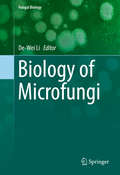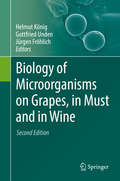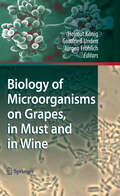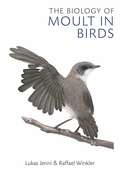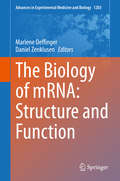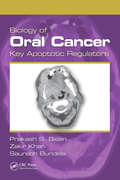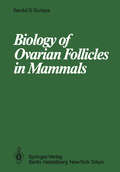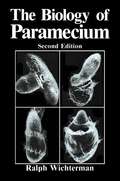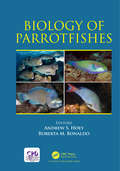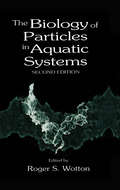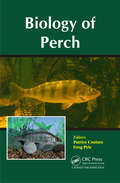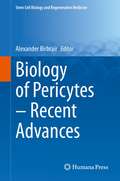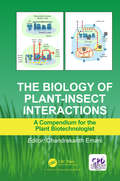- Table View
- List View
Biology of Longevity and Aging: Observations and Principles
by Robert ArkingThe latest edition of Robert Arking's seminal text on the biology of aging takes on an extended title, since the field of gerontology has advanced to a point at which it is possible to separate the topic into two implicit subsets, longevity and aging. This multi-faceted description of the biology of aging guides the reader through increasingly interesting answers to seven fundamental questions: What is aging? Why do we age? What mechanisms support extended longevity? What determines the onset of senescence? What is the mechanistic basis of senescence? Why do humans live so long? And lastly, what pro-longevity societal interventions are needed? Inevitably, humans will age but there is no reason why we must suffer from age-related diseases. Aging and longevity are dependent on both genes and social environment. Our biology does not forbid the modulation of aging. What we really want to know is not so much about the biology of aging - which is basically a degenerative process - but rather about biological processes underlying the long term maintenance of our health. New chapters incorporate the latest developments in the field of gerontology. Research done since the previous edition was published has given us insight into how we may stay healthier longer.
The Biology of Mallomonas: Morphology, Taxonomy and Ecology (Developments in Hydrobiology #63)
by P.A. SiverThe Biology of Mammalian Spermatogonia
by Jon M. Oatley Michael D. GriswoldThis book provides a resource of current understandings about various aspects of the biology of spermatogonia in mammals. Considering that covering the entire gamut of all things spermatogonia is a difficult task, specific topics were selected to provide foundational information that will be useful for seasoned researchers in the field of germ cell biology as well as investigators entering the area. Looking to the future, the editors predict that the foundational information provided in this book -- combined with the advent of new tools and budding interests in use of non-rodent mammalian models -- will produce another major advance in knowledge regarding the biology of spermatogonia over the next decade. In particular, we anticipate that the core molecular machinery driving different spermatogonial states in most, if not all, mammals will be described fully, the extrinsic signals emanating from somatic support cell populations to influence spermatogonial functions will become fully known, and the capacity to derive long-term cultures of SSCs and transplant the population to regenerate spermatogenesis and fertility will become a reality for higher order mammals.
The Biology of Mangroves and Seagrasses (Biology of Habitats Series)
by Peter J. HogarthMangroves and seagrasses form extensive and highly productive ecosystems that are both biologically diverse and economically valuable. This book, now in its third edition and fully updated throughout, continues to provide a current and comprehensive introduction to all aspects of the biology and ecology of mangroves and seagrasses. Using a global range of examples and case studies, it describes the unique adaptations of these plants to their exacting environments; the rich and diverse communities of organisms that depend on mangrove forests and seagrass meadows (including tree-climbing shrimps, synchronously flashing fireflies, and 'gardening' seacows); the links between mangrove, seagrass, and other habitats; and the evolution, biodiversity, and biogeography of mangroves and seagrasses. The economic value of mangroves and seagrasses is also discussed, including approaches to rational management of these vital resources and techniques for the restoration of degraded habitats. A final chapter, new to this edition, examines the potential effects of global climate change including sea level rise. As with other titles in the Biology of Habitats Series, particular emphasis is placed on the organisms that dominate these fascinating aquatic ecosystems although pollution, conservation, and experimental aspects are also considered. This accessible textbook assumes no previous knowledge of mangrove or seagrass ecology and is intended for senior undergraduate and graduate students, as well as professional ecologists, conservation practitioners, and resource managers.
The Biology of Mangroves and Seagrasses (Biology of Habitats Series)
by Peter J. HogarthMangroves and seagrasses form extensive and highly productive ecosystems that are both biologically diverse and economically valuable. This book, now in its third edition and fully updated throughout, continues to provide a current and comprehensive introduction to all aspects of the biology and ecology of mangroves and seagrasses. Using a global range of examples and case studies, it describes the unique adaptations of these plants to their exacting environments; the rich and diverse communities of organisms that depend on mangrove forests and seagrass meadows (including tree-climbing shrimps, synchronously flashing fireflies, and 'gardening' seacows); the links between mangrove, seagrass, and other habitats; and the evolution, biodiversity, and biogeography of mangroves and seagrasses. The economic value of mangroves and seagrasses is also discussed, including approaches to rational management of these vital resources and techniques for the restoration of degraded habitats. A final chapter, new to this edition, examines the potential effects of global climate change including sea level rise. As with other titles in the Biology of Habitats Series, particular emphasis is placed on the organisms that dominate these fascinating aquatic ecosystems although pollution, conservation, and experimental aspects are also considered. This accessible textbook assumes no previous knowledge of mangrove or seagrass ecology and is intended for senior undergraduate and graduate students, as well as professional ecologists, conservation practitioners, and resource managers.
Biology of Marine Fungi (Progress in Molecular and Subcellular Biology #53)
by Chandralata RaghukumarChandralata RaghukumarThe diversity, ecological role and biotechnological applications of marine fungi have been addressed in numerous scientific publications in the last few years. This enormous spurt of information has led to a dire need among students and professionals alike for a source, which contains comprehensive reviews of various aspects of marine fungi. This book addresses this need, especially since it is written by reputed marine mycologists. The latest information on topics including molecular taxonomy and phylogeny, ecology of fungi in different marine habitats such as deep sea, corals, dead- sea, fungi in extreme marine environments and their biotechnological applications is reviewed. The book presents a comprehensive source of information and analysis aimed at marine fungi for researchers, teachers and students of marine mycology.
The Biology of Mediterranean-Type Ecosystems (Biology of Habitats Series)
by Karen J. Esler Anna L. Jacobsen R. Brandon PrattThe world's mediterranean-type climate regions (including areas within the Mediterranean, South Africa, Australia, California, and Chile) have long been of interest to biologists by virtue of their extraordinary biodiversity and the appearance of evolutionary convergence between these disparate regions. These regions contain many rare and endemic species. Their mild climate makes them appealing places to live and visit and this has resulted in numerous threats to the species and communities that occupy them. Threats include a wide range of factors such as habitat loss due to development and agriculture, disturbance, invasive species, and climate change. As a result, they continue to attract far more attention than their limited geographic area might suggest. This book provides a concise but comprehensive introduction to mediterranean-type ecosystems. It is an accessible text which provides an authoritative overview of the topic. As with other books in the Biology of Habitats Series, the emphasis in this book is on the organisms that dominate these regions although their management, conservation, and restoration are also considered.
Biology of Menopause (Serono Symposia USA)
by Francis L. BellinoBiology of Menopause presents the proceedings of an international symposium held from September 10-13, 1998 in Newport Beach, CA. The proceedings review current knowledge and explores future research directions on the biologic changes of the hypothalamic-pituitary-ovarian axis across the menopausal transition and the associated changes in physiologic systems outside of the HPO axis, including the brain, the musculoskeletal and cardiovascular systems. Additionally, chapters present new methods of study and emerging areas of research.
Biology of Microfungi (Fungal Biology #0)
by De-Wei LiThis reference book includes 24 chapters written by a group of experts in the different fields of microfungi and cover a broad range of topics on microfungi. It provides the most updated information on the latest development in systematics and taxonomy of microfungi, new techniques which were developed in the last ten years and their application in microfungal research. After the International Code of Nomenclature for algae, fungi, and plants (Melbourne Code) was adopted by the Eighteenth International Botanical Congress Melbourne, Australia, July 2011, it has had a profound impact on mycology and its research. Fungal nomenclature changes and its significance to fungal taxonomy and naming of microfungi in the future is discussed in detail. Since dual names system for fungi developing both sexual and asexual states, and fungi developing only asexual state is no longer available, the first five chapters will clarify some confusion and provides perspective views on the direction for future research. The next nine chapters cover microfungi and their ecological roles or functions in the different habitats (air, indoor, aquatic, marine, plants, soils, etc). The remaining 13 chapters cover the relationship of microfungi and humans (good and bad) and usage or application microfungi in different industries, such as food, agriculture, forestry, green technology, pharmaceutics, and medicine, as well as in our daily life. The book bridges the gap between basic mycological research and applied mycology and provide readers a unique set of information and knowledge of microfungi generated from multiple angles in different fields of mycology.
Biology of Microorganisms on Grapes, in Must and in Wine
by Helmut König Gottfried Unden Jürgen FröhlichThe second edition of the book begins with the description of the diversity of wine-related microorganisms, followed by an outline of their primary and energy metabolism. Subsequently, important aspects of the secondary metabolism are dealt with, since these activities have an impact on wine quality and off-flavour formation. Then chapters about stimulating and inhibitory growth factors follow. This knowledge is helpful for the growth management of different microbial species. The next chapters focus on the application of the consolidated findings of molecular biology and regulation the functioning of regulatory cellular networks, leading to a better understanding of the phenotypic behaviour of the microbes in general and especially of the starter cultures as well as of stimulatory and inhibitory cell-cell interactions during wine making. In the last part of the book, a compilation of modern methods complete the understanding of microbial processes during the conversion of must to wine.This broad range of topics about the biology of the microbes involved in the vinification process could be provided in one book only because of the input of many experts from different wine-growing countries.
Biology of Microorganisms on Grapes, in Must and in Wine
by Helmut König Gottfried Unden Jürgen ÖhlichThe ancient beverage wine is the result of the fermentation of grape must. This n- urally and fairly stable product has been and is being used by many human societies as a common or enjoyable beverage, as an important means to improve the quality of drinking water in historical times, as therapeutical agent, and as a religious symbol. During the last centuries, wine has become an object of scientific interest. In this respect different periods may be observed. At first, simple observations were recorded, and subsequently, the chemical basis and the involvement of microorg- isms were elucidated. At a later stage, the scientific work led to the analysis of the many minor and trace compounds in wine, the detection and understanding of the biochemical reactions and processes, the diversity of microorganisms involved, and the range of their various activities. In recent years, the focus shifted to the genetic basis of the microorganisms and the molecular aspects of the cells, including metabolism, membrane transport, and regulation. These different stages of wine research were determined by the scientific methods that were known and available at the respective time. The recent “molecular” approach is based on the analysis of the genetic code and has led to significant results that were not even imaginable a few decades ago. This new wealth of information is being presented in the Biology of Microorganisms on Grapes, in Must, and in Wine.
The Biology of Moult in Birds
by Lukas Jenni Raffael WinklerFeathers are amazing structures unique to birds and, for a variety of reasons, they need to be renewed periodically as a whole in a process called moult. During this process, all of the functions of plumage are impaired and most aspects of a bird's life are affected. Every moult determines a bird's appearance anew, and restores plumage efficacy for flight and insulation. Moult profoundly affects physiology and the organization of the annual cycle, and it constrains reproduction and migration. Given these major impacts, which are equal to the other annual challenges of reproduction and migration, it is surprising that research on moult has largely been so neglected a subject. Lukas Jenni and Raffael Winkler have brought together the widely scattered results of studies on the processes and consequences of moult in birds. This book opens with an overview of the functions of plumage, and of feather maintenance and feather wear, and then introduces the two functions of moult: replacement of worn feathers and adjustment of plumage characteristics and appearance. The body of the book then examines feather-growth and the physiology, energetics and control of moult, and how various other physiological processes interact with moult and may compensate for its costs. Significantly, the authors explain how variations in moult and feather quality affect a bird's overall plumage quality, and they highlight the resulting consequences in terms of physical performance, appearance and signalling. Finally, there is a review of all the various solutions that birds have developed to fit moult into the annual cycle.This long-awaited book covers for the first time all aspects of the biology of moult and fills an important gap in the literature, completing our understanding of how the most important annual events in a bird's life fit together into a coherent whole. It draws on a wide range of information – from penguins to small passerines, from raptors to wildfowl – to highlight the variety of the subject and to pinpoint the many gaps in our knowledge along with avenues for fruitful further research.
The Biology of Moult in Birds
by Lukas Jenni Raffael WinklerFeathers are amazing structures unique to birds and, for a variety of reasons, they need to be renewed periodically as a whole in a process called moult. During this process, all of the functions of plumage are impaired and most aspects of a bird's life are affected. Every moult determines a bird's appearance anew, and restores plumage efficacy for flight and insulation. Moult profoundly affects physiology and the organization of the annual cycle, and it constrains reproduction and migration. Given these major impacts, which are equal to the other annual challenges of reproduction and migration, it is surprising that research on moult has largely been so neglected a subject. Lukas Jenni and Raffael Winkler have brought together the widely scattered results of studies on the processes and consequences of moult in birds. This book opens with an overview of the functions of plumage, and of feather maintenance and feather wear, and then introduces the two functions of moult: replacement of worn feathers and adjustment of plumage characteristics and appearance. The body of the book then examines feather-growth and the physiology, energetics and control of moult, and how various other physiological processes interact with moult and may compensate for its costs. Significantly, the authors explain how variations in moult and feather quality affect a bird's overall plumage quality, and they highlight the resulting consequences in terms of physical performance, appearance and signalling. Finally, there is a review of all the various solutions that birds have developed to fit moult into the annual cycle.This long-awaited book covers for the first time all aspects of the biology of moult and fills an important gap in the literature, completing our understanding of how the most important annual events in a bird's life fit together into a coherent whole. It draws on a wide range of information – from penguins to small passerines, from raptors to wildfowl – to highlight the variety of the subject and to pinpoint the many gaps in our knowledge along with avenues for fruitful further research.
The Biology of mRNA: Structure and Function (Advances in Experimental Medicine and Biology #1203)
by Marlene Oeffinger Daniel ZenklusenThe book provides an overview on the different aspects of gene regulation from an mRNA centric viewpoint, including how mRNA is assembled and self-assembles in a complex consisting of RNA and proteins, and how its ability to be translated at the right time and space depends on many processes acting on the mRNAs, leading to a properly folded complex. This book shows how new technologies have led to a better understanding of these processes and their connected diseases.The book is written for scientists in fundamental and applied biomedical research working on different aspects of gene regulation. It is also targeted to an audience that is not implicated in these fields directly, but wants to gain a better understanding of mRNA biology.
Biology of Oral Cancer: Key Apoptotic Regulators
by Prakash S. Bisen Zakir Khan Saurabh BundelaDespite a decline in developed countries, cancer has consistently maintained its status as one of the top killers since time immemorial. Exploring cancer management and treatment at the molecular level, Biology of Oral Cancer: Key Apoptotic Regulators presents a key molecular event-apoptosis-in relation to genesis and progression of oral cancer. Th
Biology of Ovarian Follicles in Mammals
by S.S. GurayaBoth functions of the mammalian ovary, the endocrine and (synthesis and secretion of steroid hormones) and exocrine (production of ova), depend upon the presence and cyclic growth of follicles, as the depletion of primordial follicles from the ovary leads to cessation of these f-unctions or female reproduction in mammals, or to postmenopausal period in humans. Actually, various fertility and sterility problems at the ovarian level are related to follicles. Therefore, a thorough understanding of the biology of ovarian follicles in mammals is of fundamental interest to a wide variety of academic and scientific disciplines. Study of their structure, function, and control involves mor phology, including ultrastructure, cell biology, physiology, endocrinology, biochemis try, immunology, neurobiology and pharmacology. Zoologists take interest in comparative and evolutionary aspects of biology of ovarian follicles in many different groups of mammals. Agricultural scientists and wildlife biologists need a thorough knowledge of the biology of follicles to control more effectively fecundity in domestic animals and endangered species of mammals. Finally, clinical scientists, toxicologists and physicians want to know the normal and pathological features of ovarian follicles in women, especially in relation to health and the regulation of fertility. Having in view the great importance of studying various aspects of biology of ovarian follicles, numerous papers and reviews on several aspects of ovarian follicles are published annually in a wide variety of scientific journals.
The Biology of Paramecium
by R. WichtermanThis completely revised, updated, and expanded edition has been neces sitated by the many important newer discoveries that have been made since the publication of the first edition. That volume contained almost 2000 references from the 1600s to 1953. Since then and after an extensive search, I have accumulated some 3800 additional titles from the world's literature on Paramecium. After certain titles that largely represented abstracts and preliminary reports that were followed by full research papers were eliminated, approximately 4400 full titles from the 1600s to the present were selected for inclusion in this edition. Most of the titles in the Bibliography are the more recent ones beginning with 1953. I consider the Bibliography an important part of the book: A good title of a paper in a journal is a minature abstract of its contents. Thus, the reader who may be interested in obtaining additional information not found in the book may refer directly to the original source. A cursory examination of the Bibliography will reveal that parame cium research has extended into all branches of biology, including bio chemistry and biophysics. Like other areas of science, paramecium research has become highly specialized and fragmented. I have attempted to organize and present the basic information in one book. Because of space limitations, some items may have been dealt with briefly. It is in such instances that the Bibliography will be found to be invaluable.
Biology of Parrotfishes
by Andrew S. Hoey David Roy Bellwood Roberta M. BonaldoParrotfish are found on almost every coral reef in the world. This ubiquity and uniqueness of their feeding action make them one of the most important groups of fishes within coral reef ecosystems. But why, exactly, are parrotfish so important to reefs? Can the evolution of a particular jaw morphology and feeding action really have had such a large impact on the health and functioning of the world's coral reefs? This book introduces the reader to this fascinating group of fishes (Labridae, Scarinae), from the morphological innovation of a jaw that has the power to bite through solid calcium carbonate, to the threats currently faced by parrotfish populations around the world. It contains new insights into their diet and food processing ability, and lifehistories, and concludes with an overview of emerging and future research directions.
Biology of Parrotfishes
by Andrew S. Hoey Roberta M. BonaldoParrotfish are found on almost every coral reef in the world. This ubiquity and uniqueness of their feeding action make them one of the most important groups of fishes within coral reef ecosystems. But why, exactly, are parrotfish so important to reefs? Can the evolution of a particular jaw morphology and feeding action really have had such a large impact on the health and functioning of the world's coral reefs? This book introduces the reader to this fascinating group of fishes (Labridae, Scarinae), from the morphological innovation of a jaw that has the power to bite through solid calcium carbonate, to the threats currently faced by parrotfish populations around the world. It contains new insights into their diet and food processing ability, and lifehistories, and concludes with an overview of emerging and future research directions.
The Biology of Particles in Aquatic Systems, Second Edition
by Roger S. WottonThe Biology of Particles in Aquatic Systems, Second Edition presents the latest information on particulate and dissolved matter found in aquatic habitats ranging from small streams to oceans. Only by studying this matter can we gain an understanding of the functioning of aquatic ecosystems and thus be able to predict changes that may occur as these systems become stressed. Updated and extensively revised, this new edition covers such topics as classification of particulate and dissolved matter, origin and formation of particles aquatic systems, factors affecting particle aggregation, methods for capturing particles by benthic and planktonic animals, and the use of particulate and dissolved organic matter as food.
The Biology of Particles in Aquatic Systems, Second Edition
by Roger S. WottonThe Biology of Particles in Aquatic Systems, Second Edition presents the latest information on particulate and dissolved matter found in aquatic habitats ranging from small streams to oceans. Only by studying this matter can we gain an understanding of the functioning of aquatic ecosystems and thus be able to predict changes that may occur as these systems become stressed. Updated and extensively revised, this new edition covers such topics as classification of particulate and dissolved matter, origin and formation of particles aquatic systems, factors affecting particle aggregation, methods for capturing particles by benthic and planktonic animals, and the use of particulate and dissolved organic matter as food.
Biology of Perch
by Patrice Couture Greg PyleThe genus Perca includes only three species of fish, but they are ubiquitous and abundant in freshwater and brackish environments of the northern hemisphere, from North America to Europe and Asia. These species are important both ecologically and economically. In Biology of Perch, world-renowned specialists review and update the biology of these fi
Biology of Pericytes – Recent Advances (Stem Cell Biology and Regenerative Medicine #68)
by Alexander BirbrairPericytes were originally discovered and named more than hundred years ago as contractile cells around the blood vessel endothelial cells. Due to the lack of exclusive markers, pericytes are now defined by a combination of location, morphology and gene expression. Pericytes are attracting increasing attention as important regulators during development and during normal and disturbed organ function. In recent years, remarkable progress has been made in the identification and characterization of pericytes subpopulations and their amazing functions using state-of-art techniques. These advantages facilitated identification of molecular basis of interaction between these cells with several other more well studied cell types, and revealed key signals derived from pericytes involved in homeostasis, regeneration, and disease regulation. In the last ten years, several unexpected roles of pericytes have been discovered. It has been demonstrated that pericytes from different tissues differ in their properties as well as functions. Even more, pericytes are heterogeneous also within the same organ. This book is will describe the major contributions of pericytes to different organs biology in physiological and pathological conditions.The book will teach the readers about this so special cell type that 10 years ago was almost completely forgotten, and it was associated basically only with vascular stability. Recently, it become a very hot topic to work in. Several articles in Nature, Science and Cell have been and are being currently published about this cell type. These recent works are revealing how important those cells are for before unimaginable biological processes.Thus, this book will update us on what are the most novel functions attributed to these cells. Also, will introduce to the young generation all the history about these cells from when they were discovered in different organs till where we are now in this field. So it will be a great book for both cell biology students as well as researchers that will have an update on these cells biology in different organs.
The Biology of Plant-Insect Interactions: A Compendium for the Plant Biotechnologist
by Chandrakanth EmaniOverviews of biochemical, genetic, and molecular perspectives of plant-insect interactions with added emphasis on bioinformatic, genomic, and transcriptome analysis are comprehensively treated in this book. It presents the agro-ecological and evolutionary aspects of plant-insect interactions with an exclusive focus on the climate change effect on the resetting of plant-insect interactions. A valuable resource for biotechnologists, entomologists, agricultural scientists, and policymakers, the book includes theoretical aspects as a base toward real-world applications of holistic integrated pest management in agro-ecosystems.
